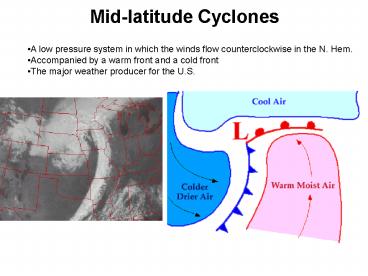Mid-latitude Cyclones - PowerPoint PPT Presentation
1 / 7
Title:
Mid-latitude Cyclones
Description:
Mid-latitude Cyclones. A low pressure system in which the winds flow ... Cyclogenesis is the formation of ... Conversely, increasing upper-level vorticity leads ... – PowerPoint PPT presentation
Number of Views:378
Avg rating:3.0/5.0
Title: Mid-latitude Cyclones
1
Mid-latitude Cyclones
- A low pressure system in which the winds flow
counterclockwise in the N. Hem. - Accompanied by a warm front and a cold front
- The major weather producer for the U.S.
2
Mid-latitude Cyclones
Figure 18.9 on pg. 502
- Lifecycle 6 stages
- Formation
- Wave development
- Development of cyclonic flow
- Occlusion
- Storm intensification
- Cyclone dissipation
3
Cyclogenesis is the formation of a mid-latitude
cyclone. Initially, the polar front separates the
cold easterlies and the warmer westerlies.
As cyclogenesis begins, a kink develops along
the boundary. The cold air north of the front
begins to push southward behind the cold front,
and air behind the warm front advances northward,
creating a counterclockwise rotation around a
weak low-pressure system.
4
With further intensification, the low pressure
deepens even further and distinct warm and cold
fronts emerge from the original polar front.
Convergence associated with the low pressure can
lead to uplift and cloud formation, while linear
bands of deeper cloud cover develop along the
frontal boundaries.
Occlusion represents the end of the cyclones
life cycle and takes place as the center of the
low pressure pulls back from the warm and cold
fronts.
5
The figure depicts the typical structure of a
mature cyclone and the processes causing
uplift. Shaded areas represent the presence of
cloud cover. The numbers represent an
approximation of the precipitation probability.
6
Divergence in the upper atmosphere, caused by
decreasing vorticity, draws air upward from the
surface and provides a lifting mechanism for the
intervening column of air. This can initiate and
maintain low-pressure systems at the surface.
Conversely, increasing upper-level vorticity
leads to convergence and the sinking of air,
which creates high pressure at the surface.
Surface low-pressure systems resulting from
upper-tropospheric motions are called dynamic
lows and are distinct from thermal lows caused by
localized heating of air from below.
7
- NOW LETS DISCUSS THE WEATHER ASSOCIATED WITH A
MID-LAT CYCLONEPLEASE SEE THE HANDOUT GIVEN.































